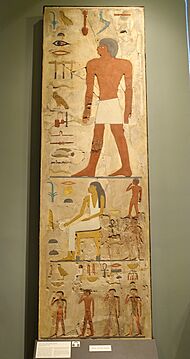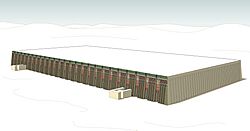Nefermaat facts for kids
Quick facts for kids
Nefermaat I
|
||||
|---|---|---|---|---|
| Nfr-m3ˁt justice is beautiful
|
||||

A stele from the University of Chicago. The top layer depicts Nefermaat. The middle depicts his wife Itet seated, behind her an unknown child (top) and Ankherfenedjef (bottom). The bottom layer depicts four more of their children, from left to right, Wehemka, an unknown child, Ankhersheretef, and Nebkhenet.
|
||||
| Resting place | mastaba 16, Meidum | |||
| Occupation | vizier royal seal bearer prophet of Bastet |
|||
| Spouse(s) | Itet | |||
| Children | Vizier Hemiunu; several others | |||
| Parent(s) | Sneferu and unknown wife | |||
Nefermaat I lived in ancient Egypt around 2575–2551 BC. He was a prince, meaning he was the son of a king. His father was Sneferu, a very important king who started the Fourth Dynasty of Egypt.
Nefermaat held several important jobs. He was a vizier, which was like a prime minister or a top advisor to the king. He was also the king's eldest son and held the title of "royal seal bearer." This meant he was in charge of official documents. He was also a priest, known as a "prophet of Bastet," a goddess often shown as a cat. His name, Nefermaat, means "Maat is beautiful" or "With perfect justice."
Nefermaat's Family Life
Nefermaat was the oldest son of King Sneferu and his first wife. This made him the half-brother of Khufu, who later built the Great Pyramid of Giza.
Nefermaat was married to a woman named Itet. They had a very large family! Their tomb lists fifteen children. Some of their sons, like Hemiunu, Isu, Teta, and Khentimeresh, and daughters, Djefatsen and Isesu, are shown as adults in their tomb. Many other children, including Itisen, Inkaef, Serfka, Wehemka, and others, are shown as kids.
One of Nefermaat's sons, Hemiunu, might be the same vizier who helped plan the famous Great Pyramids. Nefermaat also had a sister named Nefertkau, who had a son also named Nefermaat.
Nefermaat's Unique Tomb
Nefermaat was buried in a special type of tomb called a mastaba. A mastaba is a large, flat-topped, rectangular tomb with sloping sides, built for important people in ancient Egypt. His tomb, called mastaba 16, is located in Meidum. Many of King Sneferu's relatives were buried there.
Nefermaat's tomb is famous for its unique way of decorating scenes. Instead of just painting on the walls, the artists first carved deep outlines into the stone. Then, they filled these carved lines with a colorful paste. This method made the scenes look very bright and lively. However, it was a lot of work, and the paste often dried out, cracked, and fell off over time. Because of this problem, this special technique was not used much in other tombs.
The Famous Meidum Geese Painting
One of the most famous artworks from Nefermaat's tomb is a painting known as the "Meidum Geese." This painting is now kept in the Egyptian Museum in Cairo. It was found in 1871 by archaeologists Auguste Mariette and Luigi Vassalli.
The painting shows six geese. Three geese face to the left, and three face to the right. In each group of three, one goose has its head down, eating, while the other two have their heads held high. In ancient Egyptian art, showing three animals often meant there were "many" of them. The geese in the painting are different types, including greylag, greater white-fronted, and red-breasted geese. This painting is considered a masterpiece of ancient Egyptian art because of its detailed and lifelike depiction of the birds.
Over the years, there have been some discussions about the painting. In 2015, one researcher suggested it might have been made in the 1800s, not ancient Egypt. However, this idea was quickly disagreed with by many Egyptian experts. More recently, studies have looked at whether the geese in the painting perfectly match modern species. While some geese match well, others, like the red-breasted geese, show slight differences. This could be because artists sometimes changed things for their art, or it might even show a type of goose that no longer exists today.
- The Meidum Geese
-
Left section with a greylag and two white-fronted geese
-
Right section with a greylag and two red-breasted geese





